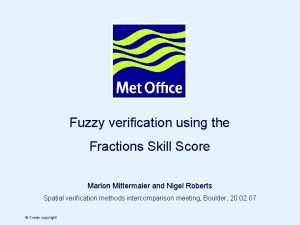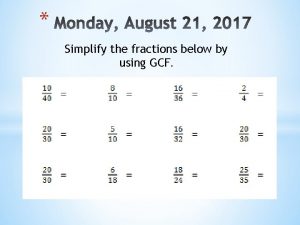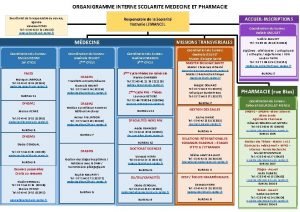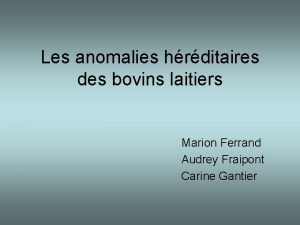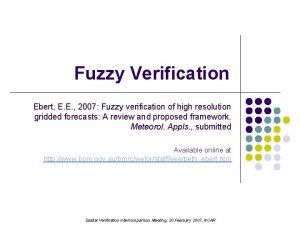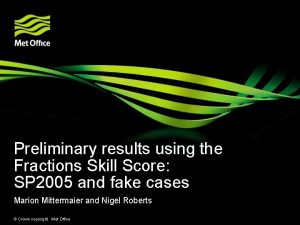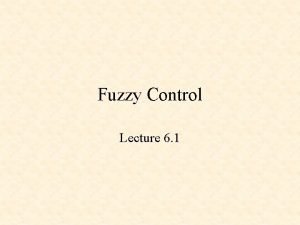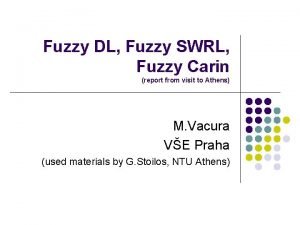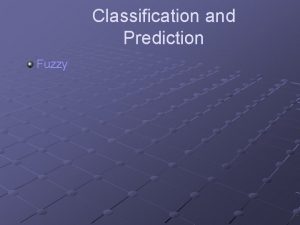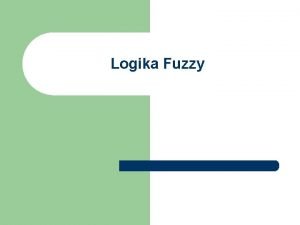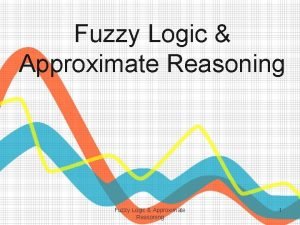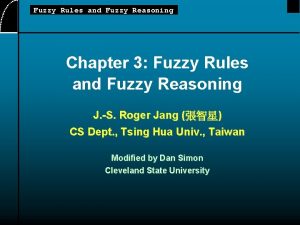Fuzzy verification using the Fractions Skill Score Marion















- Slides: 15

Fuzzy verification using the Fractions Skill Score Marion Mittermaier and Nigel Roberts Spatial verification methods intercomparison meeting, Boulder, 20. 02. 07 © Crown copyright Page 1

Verification approach We want to know 1. How the forecast skill varies with neighbourhood size. 2. The smallest neighbourhood size that can be used to give sufficiently accurate forecasts. 3. Does higher resolution provide more accurate forecasts on scales of interest (e. g. river catchments) Compare forecast fractions with fractions from radar over different sized neighbourhoods (squares for convenience) using GRIDDED data. Use rainfall accumulations to apply temporal smoothing Scale-selective verification of rainfall accumulations from high-resolution forecasts of convective events by Roberts and Lean (accepted in MWR, Feb 2007) Page 2

Schematic comparison of fractions observed forecast Threshold exceeded where squares are blue © Crown copyright Page 3

A score for comparing fractions with fractions Brier score for comparing fractions Skill score for fractions/probabilities - Fractions Skill Score (FSS) © Crown copyright Page 4

Example graph of FSS against neighbourhood size © Crown copyright Page 5

Strengths and weaknesses Strengths Weaknesses 1. Measures skill on fair terms from the model perspective. 1. The spatial skill signal may be swamped by the bias. 2. It gets round the double penalty problem by sampling around precipitation areas. 2. Sensitivity to small base rates at higher thresholds, i. e. is threshold dependent (as any method using thresholds!) 3. It can be used to determine the scale over which a forecast system has sufficient skill. 3. Like any score, it doesn't tell the whole story on its own. 4. The method is intuitive and can be directly related to the way forecasts are presented. i. e. generating spatial probability forecasts. 5. It is particularly useful for highresolution precipitation forecasts in which we expect the fine detail to be unpredictable. 6. It can be used for single or composite events. © Crown copyright Page 6

13 May 2005 © Crown copyright Page 7

Max = 94 mm (3. 7 in) Max = 78 mm (3. 1 in) Hourly accumulations Max = 98 mm (3. 9 in) © Crown copyright Max = 48 mm (1. 9 in) Page 8

Physical thresholds Increasing bias for higher thresholds mm in 0. 04 0. 08 0. 16 0. 32 0. 64 1. 28 ~60 mi © Crown copyright Page 9

Frequency thresholds Top 25, 5 and 1 % of the distribution (including zeros) representative of rain/no rain boundary 0. 5 -1 mm (0. 02 -0. 04 in) 4 -6 mm (0. 16 -0. 24 in) ~60 mi Ø >75% zeros in domain Ø top 1% are values ~ 5 mm (0. 2 in) or more (large range) Ø 1% of pixels is ~ 3000 (still a lot) © Crown copyright Page 10

1 June 2005 © Crown copyright Page 11

Max = 120 mm (4. 7 in) Max = 84 mm (3. 3 in) Hourly accumulations Max = 69 mm (2. 7 in) © Crown copyright Max = 74 mm (2. 9 in) Page 12

Physical thresholds mm in 0. 04 0. 08 0. 16 0. 32 0. 64 1. 28 ~60 mi © Crown copyright Page 13

Frequency thresholds 0. 5 -1 mm (0. 02 -0. 04 in) representative of rain/no rain boundary 4 -6 mm (0. 16 -0. 24 in) ~60 mi © Crown copyright Page 14

Issues The following points have cropped up and are listed here as general issues or specific to the FSS. At the very least they require a bit more thought and possibly some extra tests. § Currently FSS is computationally expensive (run time dependent on domain size). § Results may be domain size dependent (a larger domain gives the scope for larger spatial errors). Other spatial methods may suffer in the same way. (Do we know enough about this? ) § Independence issues (regarding adjacent pixels). This affects all spatial-based methods. (Should we be worried? ) § Impact of data sparseness(? ), domain edge effects. A bit of a grey area but again may apply more widely. © Crown copyright Page 15
 Fractions skill score
Fractions skill score Fuzzy sets and fuzzy logic theory and applications
Fuzzy sets and fuzzy logic theory and applications Hard skill
Hard skill Heidke skill score
Heidke skill score The life skill using community resources means
The life skill using community resources means Explanation skill in microteaching
Explanation skill in microteaching Simplifying fractions using gcf
Simplifying fractions using gcf Bone density z score
Bone density z score T-score statistics
T-score statistics Marion stanton
Marion stanton Marion welchman
Marion welchman Howard irwin titanic
Howard irwin titanic Marion easton
Marion easton Scolarité pharmacie nantes
Scolarité pharmacie nantes Marion desktop
Marion desktop Marion ferrand
Marion ferrand
